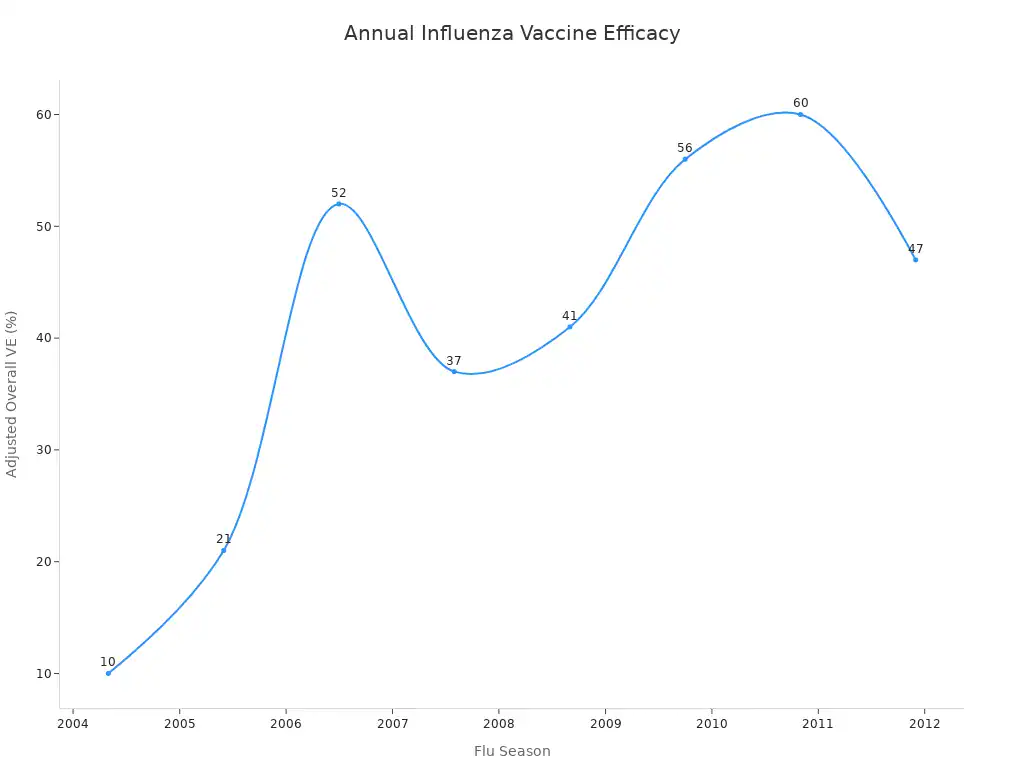
Yes, you can get sick again with the flu even after your recent recovery. It is possible to get the flu more than once. This is not uncommon. Different flu strains cause this. The flu virus also changes. These new strains mean your body has no protection. Experts suggest getting the flu twice with the same strain in the same season is rare. However, other strains of flu can still make you ill during one flu season. There are many strains circulating.
Key Takeaways
You can get the flu more than once. Different flu strains and changes in the virus make this possible.
The flu shot helps protect you. It can make the flu milder if you still get sick.
Practice good hygiene. Wash your hands often and clean surfaces to stop the flu from spreading.
Support your immune system. Eat well and exercise to help your body fight off illness.
See a doctor for serious symptoms. Look for trouble breathing or a very high fever.
Why You Can Get The Flu Again

You might wonder why you can get sick again with the flu even after recovering. Your body builds immunity to the specific flu virus you had. However, several factors make it possible to get the flu twice, sometimes even in the same season. This section explains the biological reasons behind flu reinfection.
Different Flu Strains
The flu virus is not just one type. Multiple strains circulate each year. When you get the flu, your body develops immunity to that specific strain. If you encounter a different strain, your existing immunity may not protect you. You can then fall ill. Typically, during a single flu season, you might find:
One influenza A(H1N1) virus
One influenza A(H3N2) virus
One influenza B/Victoria lineage virus
These are distinct strains. Each strain has unique surface proteins. These proteins are Hemagglutinin (HA) and Neuraminidase (NA). The HA protein helps the virus enter your cells. The NA protein helps new viruses leave your cells. Your body creates antibodies against these specific proteins. If you encounter a new strain with different HA and NA proteins, your body may not recognize it. This means you can become ill again.
Viral Mutation And Drift
The flu virus constantly changes. This process is called antigenic drift. It is a key reason you can get the flu twice. Antigenic drift causes small changes in the HA proteins. These changes happen in critical areas. They alter how your antibodies recognize the virus. Your previous immunity becomes less effective. The virus can then bypass your existing antibody responses. This allows drifted strains to escape your pre-existing immunity. You can get sick again because your body no longer fully recognizes the altered virus.
Weakened Immune System
Your immune system plays a vital role in fighting off the flu. If your immune system is weakened, you are more vulnerable. Even if you had the flu before, a compromised immune response can make you susceptible to another illness. Several medical conditions or treatments can weaken your immunity:
HIV infection
Solid-organ transplants
Haemopoietic stem-cell transplants
Chemotherapy
Chronic haemodialysis
Corticosteroid use
Congenital immunodeficiencies
If you have one of these conditions, your body struggles to fight off viruses. This increases your risk of getting the flu twice.
Secondary Infections
Sometimes, you feel sick again after the flu, but it is not the flu itself. The flu weakens your respiratory system. This makes you more prone to other infections. These are called secondary infections. Bacteria often cause these infections. They can lead to more severe illness.
Common bacterial secondary infections include:
Streptococcus pneumoniae
Haemophilus influenzae
Staphylococcus aureus
These bacteria are frequently found in co/secondary infections during flu pandemics. For example, during the 2009 Swine Flu Pandemic, S. pneumoniae was a common bacterial agent in fatal cases. Secondary bacterial pneumonia is a serious concern. More than two-thirds of fatal cases during the 1957 influenza pandemic linked to bacterial pneumonia. About 29% of fatal H1N1 cases in 2009 involved a secondary bacterial infection. If you develop a viral pneumonia, there is a 32% chance you also get a bacterial pneumonia. These secondary infections can make you feel sick again, even after the flu virus is gone.
Differentiating Recurring Flu
You might feel sick again after having the flu. It is important to know if you have a new flu, another illness, or just lingering symptoms. This section helps you understand the differences. You can then take the right steps for your health.
Cold Versus Flu Symptoms
You often confuse the common cold and the flu. They share many symptoms, but key differences exist. Knowing these differences helps you identify what you have.
Symptom/Characteristic | Common Cold | Flu |
|---|---|---|
Onset | Gradual | Sudden |
Duration | About a week | 1-2 weeks |
Fever | Low-grade (common) | Higher (typical) |
Body Aches | Rare | Intense (often associated) |
A cold usually starts slowly. You might first notice a sore throat or sneezing. Common cold symptoms include:
Sneezing
Stuffy nose
Sore throat
Coughing
Post-nasal drip
Watery eyes
Mild headache
Mild body aches
Cold symptoms can last up to two weeks. They rarely cause serious health issues. The flu, however, hits you suddenly. You often feel much worse with the flu. You will likely experience a higher fever and intense body aches. These flu symptoms are more severe.
Symptom/Characteristic | Common Cold | Flu |
|---|---|---|
Onset | Short, mild illness; symptoms increase rapidly, peaking 2-3 days after infection | Typically sudden |
Early Symptoms | Headache, sneezing, chilliness, sore throat | Fever, headache, cough, sore throat, myalgia, nasal congestion, weakness, loss of appetite |
Fever | Rarely associated with fever; some subjects have transient depression of oral temperature | Characteristic |
Key Predictors for Differentiation | (Not specified as predictors for cold) | Cough and fever (positive predictive value of ~80%) |
If you have a cough and fever, you likely have the flu. These two flu symptoms are strong indicators.
Other Respiratory Viruses
Many other viruses cause symptoms similar to the flu. You might think you have the flu again, but another virus could be making you sick. These viruses often cause seasonal colds. They present with upper respiratory signs. You might experience a runny nose, sore throat, sneezing, cough, and watery eyes.
Other respiratory viruses include:
Rhinoviruses (most common cause of colds)
Coronaviruses (excluding SARS and COVID-19)
Respiratory Syncytial Virus (RSV)
Respiratory Adenoviruses
Human Parainfluenza Viruses (HPIV)
SARS-CoV-2 (COVID-19)
These symptoms are not unique to any single virus. Almost all known respiratory viruses can cause any combination of them. You cannot tell the exact virus just by your symptoms. For example, common colds are generally self-limiting. They last about 9–10 days. Acute laryngitis, often caused by the same viruses, typically lasts 3 to 8 days. You might feel sick for a while, but it is not always the flu.
Post-Viral Syndrome
Sometimes, you continue to feel unwell even after the flu virus leaves your body. This is called post-viral syndrome. It is not a new infection. Instead, it involves lingering symptoms from your body’s fight against the initial illness. Your body needs time to fully recover.
Common lingering symptoms of post-viral syndrome include:
Extreme fatigue
Muscle weakness
Brain fog or difficulty concentrating
Headaches
Joint pain
Persistent cough
These lingering symptoms can last for weeks or even months. They indicate your body is still recovering. You should rest and take care of yourself during this time.
Other Post-Flu Conditions
The flu can sometimes lead to other health problems. These are not new flu infections. They are complications or conditions triggered by the initial illness. Your body’s immune response to the flu can affect various systems.
For example, the flu can impact your cardiovascular system. The influenza virus can directly infect your heart. It can also cause inflammation throughout your body. This inflammation increases metabolic demand. It creates biomechanical stress. You might experience hypoxemia or hypercoagulability. The virus triggers pro-inflammatory cytokines and chemokines. These recruit immune cells.
The influenza virus can even reach your heart through circulation. It can stay there long after it leaves your lungs. This persistence can change your cardiac proteins. It leads to inflammation, mitochondrial damage, and oxidative stress. This can cause cardiac injury. You might develop conditions like myocarditis (inflammation of the heart muscle). The flu can also worsen existing chronic conditions. These conditions make you feel sick again, but they are different from a new flu.
Preventing Flu Reinfection

You can take important steps to avoid getting the flu again. These actions help protect your health throughout the flu season.
Vaccination Importance
Getting your annual flu shot is a key step. The flu shot helps your body build immunity. It prepares your immune system to fight the flu. Even if you get the flu after your flu shot, the illness is often milder. Studies show that your flu shot reduces symptom severity and duration. It also lowers your risk of hospitalization, ICU admission, or death. For example, a quadrivalent inactivated flu shot showed 73% efficacy against moderate-to-severe disease. Getting your flu shot is a smart choice.
The flu shot’s effectiveness varies each year. Here is a look at past flu shot efficacy:
Flu Season | Adjusted Overall VE (%) |
|---|---|
2009-10 | 56 |
2010-11 | 60 |
2011-12 | 47 |
2012-13 | 49 |
2013-14 | 52 |
2014-15 | 19 |
2015-16 | 48 |
2016-17 | 40 |
2017-18 | 38 |
2018-19 | 29 |
2019-20 | 39 |
2020-21 | Not enough data to compute |
2021-22 | 36 |
2022-23 | 30 |
2023-24 | 44 |
2024-25 | 56 |

This flu shot data shows the importance of getting your flu shot every year. Your flu vaccination helps protect you.
Good Hygiene Practices
Good hygiene also helps prevent flu reinfection. Wash your hands often with soap and water. Hand hygiene is effective for general infection control. Some studies show handwashing reduces flu transmission in households. Clean high-touch surfaces regularly. Wipe down door handles, light switches, and countertops. Aim to clean these surfaces twice a day. Deep clean them at least once daily. This helps remove flu viruses.
Immune System Support
Support your immune system. Eat a balanced diet. Deficiencies in vitamins C, D, B-6, B-12, folic acid, and zinc can weaken your immunity. These nutrients are vital for a strong immune response. Regular physical activity also boosts your immune system. Exercise can improve your body’s response to the flu shot. It helps your body fight off the flu.
Avoiding Close Contact
Avoid close contact with sick people. Keep a distance of 3-6 feet from others. This reduces the risk of droplet transmission. Wear a medical facemask when you are in crowded places. Masks can reduce the risk of flu transmission. Combining mask use with handwashing offers even more protection. These steps help protect yourself from the flu.
When To Seek Medical Attention
You need to know when to seek medical help after having the flu. Sometimes, your body needs extra support. Watch for specific signs. These signs tell you when to contact a doctor.
Worsening Or New Symptoms
You might feel better after the flu, but then new problems appear. These new or worsening symptoms need medical attention. For example, you might experience:
Difficulty breathing, chest pain, or shortness of breath.
Severe or persistent vomiting, dehydration, or dizziness.
A high fever that won’t come down (above 103°F in adults, 102°F in children).
Confusion, fainting, or a sudden worsening after initial improvement.
Flu symptoms lasting longer than 10–14 days.
These are not typical flu symptoms for recovery. You should contact your doctor if you notice these changes.
High-Risk Individuals
Certain people face a higher risk from the flu. You are in a high-risk group if you are:
A child younger than 5, especially those younger than 2 years old. Infants younger than 6 months old have the highest hospitalization and death rates.
An adult 65 years of age and older.
A pregnant woman.
Someone with chronic conditions like asthma, heart disease, diabetes, or a weakened immune system.
If you are in a high-risk group for complications, you should seek medical advice quickly. Your body might struggle more with flu symptoms.
Signs Of Complications
The flu can lead to serious complications. You must recognize these critical warning signs. For adults, watch for:
Trouble breathing or difficulty drawing a full breath.
Unrelenting high fever.
Severe chest pain or persistent pain/pressure in the chest or abdomen.
Sudden confusion or inability to arouse.
Bluish lips, face, or nails.
For children, look for:
Fast breathing or trouble breathing.
Bluish lips or face.
Ribs pulling in with each breath.
Chest pain.
Any fever in children younger than 12 weeks.
These signs mean you need emergency care.
Persistent Symptoms
Sometimes, flu symptoms just do not go away. You might feel sick for a long time. If your flu symptoms last longer than 10–14 days, you should talk to your doctor. Persistent exhaustion or a cough that does not improve also warrants a medical check. Your body might need help to fully recover.
You can get sick again with the flu. Different flu strains and viral evolution make it possible to get the flu twice, even if you just recovered. You might not get the exact same strain in the same season, but other strains can still make you ill. Protect yourself throughout the flu season. Get your annual flu shot. Practice good hygiene. Support your immune system. Stay vigilant. Seek medical advice if you have severe or persistent symptoms.
FAQ
Can you get the flu more than once in a single season?
Yes, you can get the flu more than once. Different flu strains circulate each year. Your body builds immunity to one strain. A new strain can still make you sick. Viral changes also mean your immunity may not fully protect you. 🦠
What makes flu symptoms different from a common cold?
Flu symptoms usually start suddenly. You often have a high fever and intense body aches. Colds start gradually. They typically cause milder symptoms like sneezing and a stuffy nose. A cough and fever strongly suggest the flu. 🤒
What is post-viral syndrome after the flu?
Post-viral syndrome means you feel unwell after the flu virus leaves your body. It is not a new infection. You might feel extreme fatigue, muscle weakness, or have brain fog. Your body needs time to fully recover. 😴
What are signs you need a doctor for flu symptoms?
Seek medical help for worsening or new symptoms. Look for trouble breathing, chest pain, or confusion. High-risk individuals, like young children or older adults, should also see a doctor quickly. Persistent symptoms lasting over 10-14 days also need attention. 🚨




